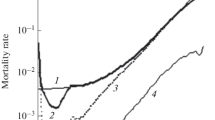Abstract
Age dynamics of human body mass (0–90 years) is described as a function of periodic damped oscillations. Common regularities are found in the age changes of mass, of entropic equivalent—a parameter equivalent to thermodynamic entropy, and of intensity of natural mortality. It is shown that the mass reflects the biological system thermodynamic state and is measured oppositely directed to the entropy value. The second, third, and fourth extremes of the mass age dynamics correspond to the mean (70–75 years), the commonly accepted maximal (100–110 years), and the maximal known (140–150 years) human lifespan, while the mass oscillations cease at the age associated with the maximal known lifespan—about 145 years.
Similar content being viewed by others
REFERENCES
Gerasimov, I.G., Use of Entropic Characteristics for Assessment of the Organism Biological Age and Functional State, Probl. Staren. Dolgolet., 1996, vol. 6, nos. 1–2, pp. 32–35.
Zotin, A.I., Termodinamicheskaya osnova reaktsii organizma na vneshnie i vnutrennie faktory (Thermodinamical Basis of Organism Responses to External and Internal Factors), Moscow, 1988.
Gerasimov, I.G., Entropy of Biological Systems, Probl. Staren. Dolgolet., 1998, vol. 8, no. 2, pp. 39–44.
Kalmykova, Z.I., Buldakov, L.A., and Tokarskaya, Z.V., Changes of Entropy of Dog Heart Mass during Inhalation of Transuranium Radionucleotides, Med. Radiol., 1992, vol. 36, no. 5, pp. 27–30.
Riggs, J.E., Aging and Mortality: Manifestations of Increasing Informational Entropy of the Genome?, Mech. Ageing Dev., 1993, vol. 66, pp. 249–256.
Arshavskii, I.A., Mechanism of Onto-and Gerontogenesis in Representatives of the Class of Mammals, Usp. Fiziol. Nauk, 1998, vol. 29, no. 4, pp. 93–107.
Kheiflik, L., Mortality and Immortality on the Cellular Level, Biokhimiya , 1997, vol. 62, pp. 1380–1393.
Riggs, J.E., Carcinogenesis, Genetic Instability and Genomic Entropy: Insight Derived from Malignant Brain Tumor Age Specific Mortality Rate Dynamics, J. Theor. Biol., 1994, vol. 170, pp. 331–338.
Hershey, D. and Lee, W., Excess Entropy Production as a Marker in Longevity Analysis, Age, 1988, no. 11, pp. 173–176.
Sacher, G.A., Maturation and Longevity in Relation to the Cranial Capacity in Hominid Evolution, Antecedent of Man and after. Primates: Functional Morphology and Evolution, 1975, pp. 417–441.
Nikolis, G. and Prigozhin, I., Samoorganizatsiya v neravnovesnykh sistemakh (Self-Organization in Non-Equilibrium Systems), Moscow, 1979.
Presnov, E.V., Formalism of Non-Equilibrium Phenomenological Thermodynamics, Termodinamika biologicheskikh protsessov (Thermodynamics of Biological Processes), Moscow, 1976, pp. 25–43.
Frolkis, V.V. and Muradyan, Kh.K., Starenie, evolyutsiya i prodlenie zhizni (Aging, Evolution and Prolongation of Life), Kiev, 1992.
Prigozhin, I., Ot sushchestvuyushchego k voznikayushchemu: Vremya i slozhnost'v fizicheskikh naukakh (From Existing to Originating: Time and Complexity in Physical Sciences), Moscow, 1985.
Zotin, A.I., Termodinamicheskii podkhod k problemam razvitiya i stareniya (Thermodinamical Approach to the Problems of Development and Aging), Moscow, 1974.
de Gross, S. and Masur, P., Neravnovesnaya termodinamika (Non-Equilibrium Thermodynamics), Moscow, 1964.
Morfologiya cheloveka (Human Morphology), Nikityuk, V.A. and Chtetsov, V.P., Eds., Moscow, 1990.
Snider, V.S., Cook, V.J., and Naseet, E.S., Chelovek. Mediko-biologicheskie dannye (Human. The Medico-Biological Data (Publication no. 23 of the International Commission on Radiological Protection)), Moscow, 1977.
Spencer, R.R., Organ/Body Weight Loss with Aging: Evidence for Coordinated Involution, Med. Hypoth., 1996, vol. 46, no. 2, pp. 59–62.
Lamb, M., Biologiya stareniya (Biology of Aging), Moscow, 1980.
Zotina, R.S. and Zotin, A.I., Differential Equations of Developmental Biology, Termodinamika biologicheskikh protsessov (Thermodynamics of Biological Processes), Moscow, 1976, pp. 83–92.
Samars, T.T. and Storms, L.H., Impact of Height and Weight on Life Span, Bull. World Health Organ., 1992, vol. 70, pp. 259–267.
Prokhorov, L.Yu., Estimation of Relations of Some Parameters Depending on Lifespan of “Permanently Aging” Cultures and Maximal Lifespan of Mammals, Tsitologiya, 1999, vol. 41, no. 10, pp. 900–913.
Colder, W.A., Body Size, Mortality, and Longevity, J. Theor. Biol., 1989, vol. 102, no. 3, pp. 135–144.
Penzes, L. and Csernai, L., On the Interrelationship between Lifespan, Constitution and Information, ZFA, 1980, vol. 35, pp. 285–296.
Vlasov, Yu.A. and Okuneva, G.N., Krovoobrashchenie i gazoobmen cheloveka: spravochnoe rukovodstvo (Human Blood Circulation and Gas Exchange: A Reference Book), Novosibirsk, 1992.
Voitenko, V.P., Elementary Events of Aging and Their Systemic Generalization, Nadezhnost i elementarnost'sobytiya stareniya biologicheskikh ob”ektov (Reliability and Elementarity of Events in Aging Processes of Biological Objects), Kiev, 1986, pp. 76–89.
Kassil', G.N., Vnutrennyaya sreda organizma (Internal Medium of an Organism), Moscow, 1983.
Solonin, Yu.G. and Chermnykh, N.A., Physiologic Parameters of Northern Men at Aging, Klinich. Gerontol., 1999, no. 4, pp. 59–63.
Frolkis, V.V., Starenie i biologicheskie vozmozhnos ti organizma (Aging and Biological Capabilities of an Organism), Moscow, 1975.
Johnson, M.A., Brown, M.A., and Poon, L.W., Nutritional Patterns of Centenarians, Int. Jagring Hum. Dev., 1992, vol. 34, no. l, pp. 57–76.
Paolisso, G., Gambardella, A., and Balbi, V., Body Composition, Body Fat Distribution, and Resting Metabolic Rate in Healthy Centenarians, Am. J. Clin. Nutr., 1995, vol. 62, pp. 746–750.
Kakhachidze, T.N., The State of Structure of Loose Connective Tissue in the process of Aging of Human Organism (in Aged, Old Ages, and Long-Living Age), Cand. Sci. Dissertation, Tbilisi, 1970.
Gavrilov, L.A. and Gavrilova, N.S., Biologiya prodolzhitel'nosti zhizni (Biology of Lifespan), Moscow, 1991.
Lamb, M., Biologiya stareniya (Biology of Aging), Moscow, 1980.
Assessment of Contribution of the Main Classes of Death Causes to the Total Mortality by Kinetic Method, Obshchie problemy biologii. Populatsionnaya gerontologiya (General Problems of Biology. Populational Gerontology), Moscow, 1987, vol. 6, pp. 130–135.
Author information
Authors and Affiliations
Rights and permissions
About this article
Cite this article
Gerasimov, I.G., Ignatov, D.Y. Age Dynamics of Body Mass and Human Lifespan. Journal of Evolutionary Biochemistry and Physiology 40, 343–349 (2004). https://doi.org/10.1023/B:JOEY.0000042639.72529.e1
Issue Date:
DOI: https://doi.org/10.1023/B:JOEY.0000042639.72529.e1



